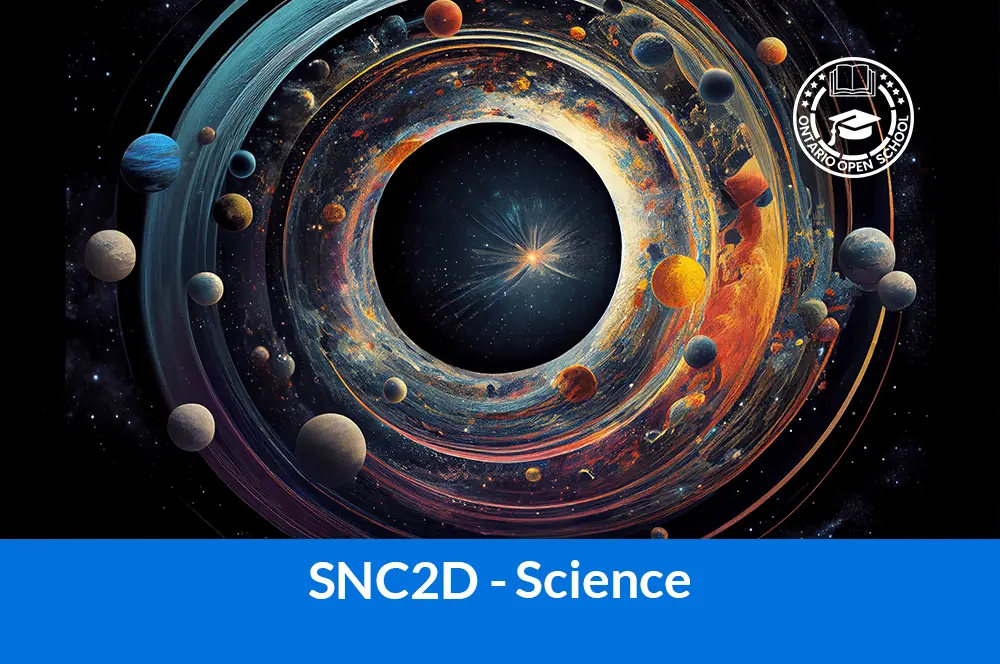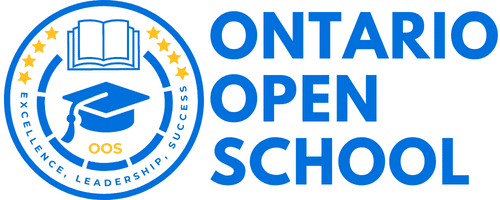- info@ontarioopenschool.com
- 647-494-4499
-
Unit 100 - 29 Gervais Drive, North York, ON.
M3C 1Y9
Copyright 2024 Ontario Open School Inc. All Rights Reserved.
This course enables students to enhance their understanding of concepts in biology, chemistry, earth and space science, and physics, and of the interrelationships between science, technology, society, and the environment. Students are also given opportunities to further develop their scientific investigation skills. Students will plan and conduct investigations and develop their understanding of scientific theories related to the connections between cells and systems in animals and plants; chemical reactions, with a particular focus on acid–base reactions; forces that affect climate and climate change; and the interaction of light and matter.
Unit Order | Unit Name | Suggested Time |
|---|---|---|
| Unit 1 | Scientific Investigation Skills and Career Exploration This unit focuses on relating science to technology, society, and the environment (STSE). The STSE expectations provide the context for developing the related skills and conceptual knowledge necessary for making connections between scientific, technological, social, and environmental issues. The STSE expectations often focus on aspects of environmental education. | Integrated throughout the course |
| Unit 2 | Biology: Tissues, Organs, and Systems of Living Things Students will demonstrate an understanding of the ways in which plants and animals, including humans, are made of specialized cells, tissues, and organs that are organized into systems. They will also evaluate the social and ethical implications of developments in medicine and medical technology. | 26 hours |
| Unit 3 | Chemistry: Chemical Reactions Students will demonstrate an understanding of the predictable ways in which chemicals react. They will also explore how chemical reactions may have a negative impact on the environment, but they can also be used to address environmental challenges. | 26 hours |
| Unit 4 | Earth and Space: Climate Change Students will demonstrate an understanding that Earth’s climate is dynamic and is the result of interacting systems and processes. They will explore how global climate change is influenced by both natural and human factors. Students will also investigate the variety of ways climate change affects living things and natural systems. Finally, they will assess the impact of human activity on climate change and to identify effective courses of action to reduce this impact. | 24 hours |
| Unit 5 | Physics: Light and Geometric Optics Students will demonstrate an understanding of the characteristics and properties of light that can be manipulated with mirrors and lenses for a range of uses. They will also explore the ways in which society has benefited from the development of a range of optical devices and technologies. | 27 hours |
| Final Evaluation 30% | Final Assignment Final Exam | 5 hours 2 hours |
| Total | 110 Hours |
A wide variety of instructional strategies are used to provide learning opportunities to accommodate a variety of learning styles, interests and ability levels. These strategies include, but are not limited to:
|
Activity Learning Center Think Pair Share Flash Cards Word wall Independent Study Computer Assited Instruction |
Oral and Media Presentation Demonstration Lecture Workbook/Worksheet Learning Journal |
Discussion Directed Reading/Thinking Activates Textbook Visualization Homework Inquiry Process |
Purpose
The primary purpose of assessment is to improve student learning. Assessment relates directly to the expectations for the course.
A variety of assessments for and as learning are conducted on a regular basis to allow ample opportunities for students to improve and ultimately demonstrate their full range of learning and for the teacher to gather information to provide feedback. Assessment tasks relate to the success criteria set out in lesson plans. Success criteria allow students to see what quality looks like.
Evaluation is the process of judging the quality of student work in relation to the achievement chart categories and criteria and assigning a percentage grade to represent that quality. Evaluation is based on gathering evidence of student achievement through:
Assessment for Learning – we provide feedback and coaching. Assessment FOR Learning is the process of seeking and interpreting evidence for the use of learners and their teachers to decide where the learners are in their learning, where they need to go, and how best to go there.
Assessment as Learning – we help students monitor progress, set goals, reflect on their learning
Assessment AS Learning is the process of the explicit fostering of students’ capacity over time to be their own best assessors, but teachers need to start by presenting and modeling external, structured opportunities for students to assess themselves.
Assessment of Learning – we use assessments to provide evaluative statements about student achievement. Assessment OF Learning is the assessment that becomes public and results in statements of symbols
(marks/grades/levels of achievement) about how well students are learning. It often contributes to pivotal decisions that will affect students’ future.
ASSESSMENT TOOLS
Assessment and Evaluation Strategies
| Units | Duration | Expectation | AFL | AAL | AOL | Assessed Categories | ||||
|
K 25% |
I
25% |
C
25% |
A 25% |
|||||||
|
70%
|
A | Integrated throughout the course | A1-A2 | Student- Teacher Conferencing | Peer Assessment |
Individual Project (Written and Oral Component) |
x | x | x | x |
| B | 27 hours | B1-B3 |
Diagnostic Quiz Class Discussion |
KWL Chart |
Unit Test Poster Presentation
|
x | x | x | x | |
| C | 28 hours | C1-C3 |
Worksheet Pair Discussion |
My Progress as a Chemist | Unit Test
Collaborative Project
|
x | x | x | x | |
| D | 25 hours | D1-D3 | Exit Card
Homework |
Reflective Discussion | Unit Test
Portfolio
|
x | x | x | x | |
| E | 30 hours | E1-E3 | Worksheet
Q/A Session Performance Task |
Student-Teacher Conferencing | Unit Test
Written Report
|
x | x | x | x | |
| 15% | Final Assignment
|
A1-A2 |
Final Project AFL: Student- Teacher Conferencing AAL: Peer Assessment AOL: Written and Presentation Component |
x | x | x | x | |||
| 15% | Final Evaluation 30% | B1-E3 | Final Project & Final Exam
|
x | x | x | x | |||
Resources
Growing Success: Assessment, Evaluation and Reporting in Ontario Schools (2010)
http://www.edu.gov.on.ca/eng/policyfunding/growSuccess.pdf
Grading
Weighting of categories
| Knowledge/Understanding | Thinking/Inquiry | Communication | Application |
| 25% | 25% | 25% | 25% |

Course Grade | Grade 10 |
|---|---|
Course Code | SNC2D |
Course Category | Science |
Course Type | Academic |
Course Delivery | Online |
Course Duration | 110h |
Course Credit | 1.00 |
Copyright 2024 Ontario Open School Inc. All Rights Reserved.
